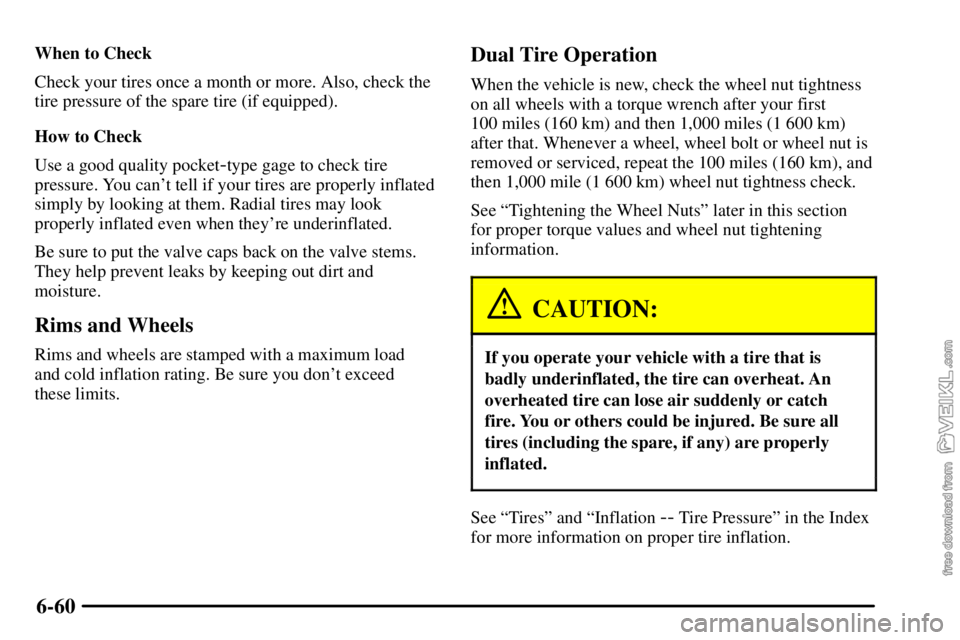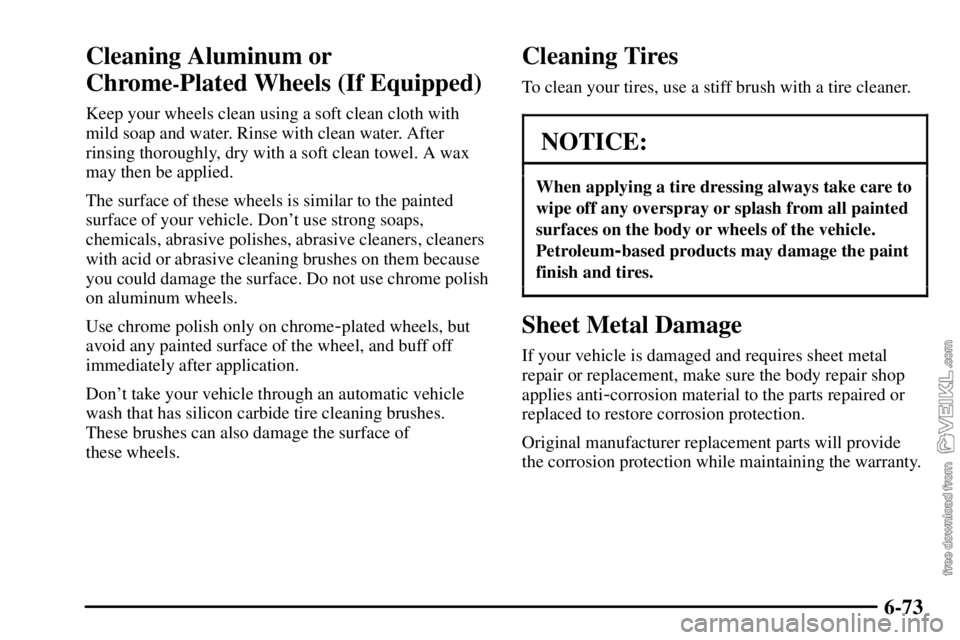Page 312 of 386

6-58
Tires
Your new vehicle comes with high-quality tires made by
a leading tire manufacturer. If you ever have questions
about your tire warranty and where to obtain service, see
your General Motors Warranty booklet for details.
CAUTION:
Poorly maintained and improperly used tires are
dangerous.
�Overloading your tires can cause
overheating as a result of too much friction.
You could have an air
-out and a serious
accident. See ªLoading Your Vehicleº in
the Index.
CAUTION: (Continued)
CAUTION: (Continued)
�Underinflated tires pose the same danger as
overloaded tires. The resulting accident
could cause serious injury. Check all tires
frequently to maintain the recommended
pressure. Tire pressure should be checked
when your tires are cold.
�Overinflated tires are more likely to be
cut, punctured or broken by a sudden
impact
-- such as when you hit a pothole.
Keep tires at the recommended pressure.
�Worn, old tires can cause accidents. If your
tread is badly worn, or if your tires have
been damaged, replace them.
Page 313 of 386
6-59 Inflation -- Tire Pressure
The GVW Rating label, which is on the driver's door,
shows the correct inflation pressures for your tires
when they're cold. ªColdº means your vehicle has
been sitting for at least three hours or driven no more
than 1 mile (1.6 km).
NOTICE:
Don't let anyone tell you that underinflation or
overinflation is all right. It's not. If your tires
don't have enough air (underinflation), you can
get the following:
�Too much flexing
�Too much heat
�Tire overloading
�Bad wear
�Bad handling
�Bad fuel economy
NOTICE: (Continued)
NOTICE: (Continued)
If your tires have too much air (overinflation),
you can get the following:
�Unusual wear
�Bad handling
�Rough ride
�Needless damage from road hazards
Page 314 of 386

6-60
When to Check
Check your tires once a month or more. Also, check the
tire pressure of the spare tire (if equipped).
How to Check
Use a good quality pocket
-type gage to check tire
pressure. You can't tell if your tires are properly inflated
simply by looking at them. Radial tires may look
properly inflated even when they're underinflated.
Be sure to put the valve caps back on the valve stems.
They help prevent leaks by keeping out dirt and
moisture.
Rims and Wheels
Rims and wheels are stamped with a maximum load
and cold inflation rating. Be sure you don't exceed
these limits.
Dual Tire Operation
When the vehicle is new, check the wheel nut tightness
on all wheels with a torque wrench after your first
100 miles (160 km) and then 1,000 miles (1 600 km)
after that. Whenever a wheel, wheel bolt or wheel nut is
removed or serviced, repeat the 100 miles (160 km), and
then 1,000 mile (1 600 km) wheel nut tightness check.
See ªTightening the Wheel Nutsº later in this section
for proper torque values and wheel nut tightening
information.
CAUTION:
If you operate your vehicle with a tire that is
badly underinflated, the tire can overheat. An
overheated tire can lose air suddenly or catch
fire. You or others could be injured. Be sure all
tires (including the spare, if any) are properly
inflated.
See ªTiresº and ªInflation -- Tire Pressureº in the Index
for more information on proper tire inflation.
Page 315 of 386
6-61 When It's Time for New Tires
Replace your tires when the tread depth is down to
1/8 of an inch (3.2 mm) for the front tires, or 1/16 of
an inch (1.6 mm) for a rear tire. Also, you need a new
tire if:
�You can see cord or fabric showing through the
tire's rubber.
�The tread or sidewall is cracked, cut or snagged deep
enough to show cord or fabric.
�The tire has a bump, bulge or split.
�The tire has a puncture, cut or other damage that
can't be repaired well because of the size or location
of the damage.CAUTION:
Mixing tires could cause you to lose control while
driving. If you mix tires of different types
-- like
radial and bias
-belted tires -- the vehicle may not
handle properly, and you could have a crash. Be
sure to use the same type of tires all around.
When you replace tires, make sure they are the same
size, load range, speed rating and construction type
(bias, bias
-belted or radial) as your original tires.
Page 320 of 386

6-66 Wheel Replacement
Replace any wheel that is bent, cracked or badly rusted.
If wheel nuts keep coming loose, replace the wheel. If
the wheel leaks air, replace it.
Your dealer will know the kind of wheel you need.
CAUTION:
A leaking wheel could fail without warning. A
wheel designed for tubeless tires could be leaking
because it is damaged. Don't use an inner tube or
some other thing to try to stop the leaking. Get a
new wheel of the proper type.
CAUTION:
Without the correct wheel, you may not be able
to stop properly, and you could have other
problems like a tire air
-out. You could have a
collision. If you don't go to your dealer to get a
new wheel, be sure you get the correct one. Each
new wheel should match the original wheel in
load
-carrying capacity, inflation pressure
capacity, diameter, width, offset and mounting
configuration.
Using wheels and tires with higher load-carrying limits
than the original wheels and tires doesn't change the
GAWR or the GVWR of your vehicle.
Page 327 of 386

6-73
Cleaning Aluminum or
Chrome
-Plated Wheels (If Equipped)
Keep your wheels clean using a soft clean cloth with
mild soap and water. Rinse with clean water. After
rinsing thoroughly, dry with a soft clean towel. A wax
may then be applied.
The surface of these wheels is similar to the painted
surface of your vehicle. Don't use strong soaps,
chemicals, abrasive polishes, abrasive cleaners, cleaners
with acid or abrasive cleaning brushes on them because
you could damage the surface. Do not use chrome polish
on aluminum wheels.
Use chrome polish only on chrome
-plated wheels, but
avoid any painted surface of the wheel, and buff off
immediately after application.
Don't take your vehicle through an automatic vehicle
wash that has silicon carbide tire cleaning brushes.
These brushes can also damage the surface of
these wheels.
Cleaning Tires
To clean your tires, use a stiff brush with a tire cleaner.
NOTICE:
When applying a tire dressing always take care to
wipe off any overspray or splash from all painted
surfaces on the body or wheels of the vehicle.
Petroleum
-based products may damage the paint
finish and tires.
Sheet Metal Damage
If your vehicle is damaged and requires sheet metal
repair or replacement, make sure the body repair shop
applies anti
-corrosion material to the parts repaired or
replaced to restore corrosion protection.
Original manufacturer replacement parts will provide
the corrosion protection while maintaining the warranty.
Page 351 of 386

7-5
Scheduled Maintenance
The services shown in this schedule up to 100,000 miles
(166 000 km) should be repeated after 100,000 miles
(166 000 km) at the same intervals for the life of
this vehicle. The services shown after 100,000 miles
(166 000 km) should be repeated at the same miles (km)
after those intervals for the life of this vehicle.
Gasoline engine vehicles have a computer that lets you
know when to change your engine oil. This is not based
on mileage, but on engine revolutions and engine
operating temperature. When the computer has
calculated that the oil needs changing, the GM Oil Life
System� will indicate that a change is necessary.
The ªFootnotesº at the end of this Maintenance
Schedule further explain maintenance services.
See ªScheduled Maintenance Supplementsº earlier in
this section.
100 Miles (160 km)
�Wheel stud nut service. (46)
1,000 Miles (1 600 km)
�Wheel stud nut service. (46)
�Rear axle air shift motor service.(11)
�L18/LB7 Engines Only: Clutch pedal free
travel service. (10)
7,500 Miles (12 000 km)
�Gasoline Engine Only: Check Oil Life System.
If engine oil and filter are changed, reset system.
See ªEngine Oilº in the Index. (3)(9)
�Check fluid levels (or every 3 months, whichever
occurs first). (1)(6)
�Chassis lubrication service (or every 6 months,
whichever occurs first). (12)
�Wheels and tires service. (15)
�Parking brake service (or every 6 months, whichever
occurs first). (8)
�L18/LB7 Engines Only: Clutch pedal free
travel service. (10)
10,000 Miles (16 000 km)
�DURAMAX� Diesel Only: Change engine oil
and filter (or every 12 months, whichever
occurs first). (2)(3)
Page 352 of 386

7-6
15,000 Miles (24 000 km)
�Gasoline Engine Only: Check Oil Life System.
If engine oil and filter are changed, reset system.
See ªEngine Oilº in the Index. (3)(9)
�Chassis lubrication service (or every 6 months,
whichever occurs first). (12)
�Check fluid levels (or every 3 months, whichever
occurs first). (1)(6)
�DURAMAX� Diesel Only: Replace fuel filter.
�Steering system service. (13)
�Front and rear suspension service. (14)
�Spring
-to-axle U-bolts and shackle bolts
service. (16)
�Exhaust system service (or every 6 months,
whichever occurs first). (3)(4)(17)
�Wheels and tires service. (15)
�Hydraulic brake service (or every 6 months,
whichever occurs first). (7)(46)
�Parking brake service (or every 6 months, whichever
occurs first). (8)
�Thermostatically controlled engine cooling fan
service. (4)(20)
�Shields and underhood insulation service. (4)(5)(21)
�L18/LB7 Engines Only: Clutch pedal free
travel service. (10)
20,000 Miles (32 000 km)
�DURAMAX� Diesel Only: Change engine oil
and filter (or every 12 months, whichever occurs
first). (2)(3)
�Air compressor dry element pleated paper air strainer
service (or every 2 months or every 800 hours,
whichever occurs first).
22,500 Miles (36 000 km)
�Gasoline Engine Only: Check Oil Life System.
If engine oil and filter are changed, reset system.
See ªEngine Oilº in the Index. (3)(9)
�Check fluid levels (or every 3 months, whichever
occurs first). (1)(6)
�Chassis lubrication service (or every 6 months,
whichever occurs first). (12)
�Inspect door hinge pins and bushings and replace
as necessary.
�Cooling system service. Clean the cooling system
filler cap with clean water, clean the core, pressure
test the cap and the system for proper pressure
capability and inspect condition of cooling and
heater hoses and clamps. Replace hoses if cracked,
swollen or damaged.